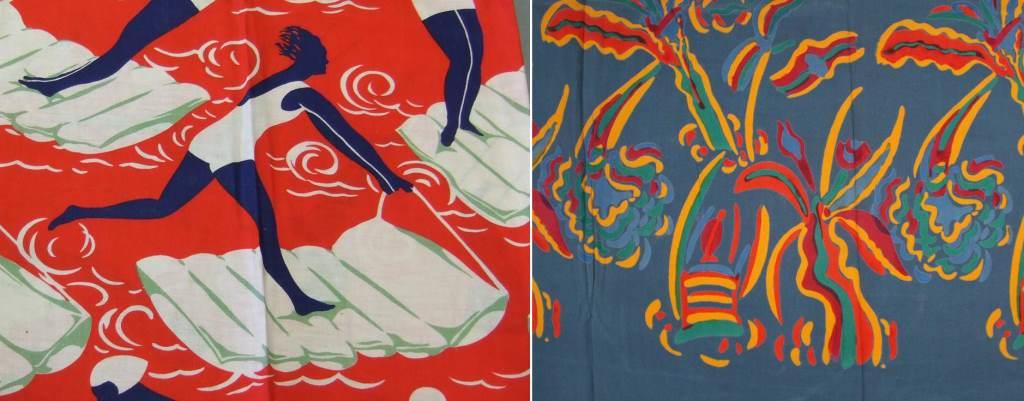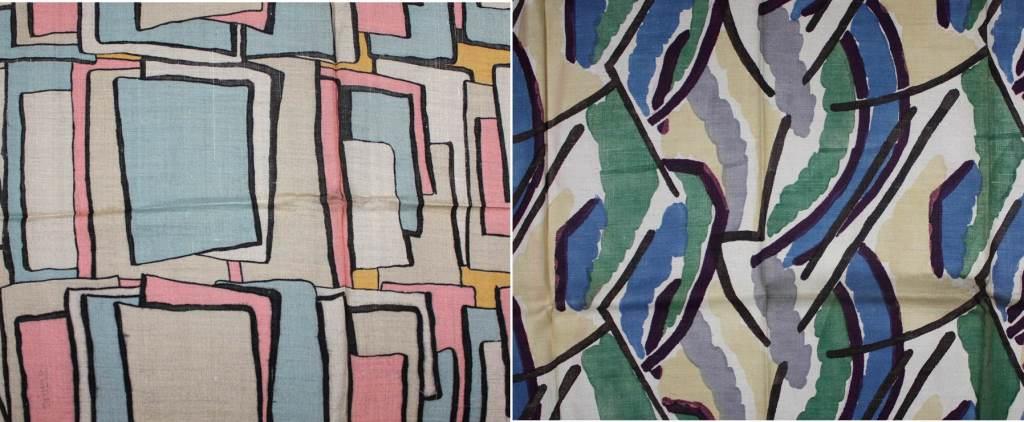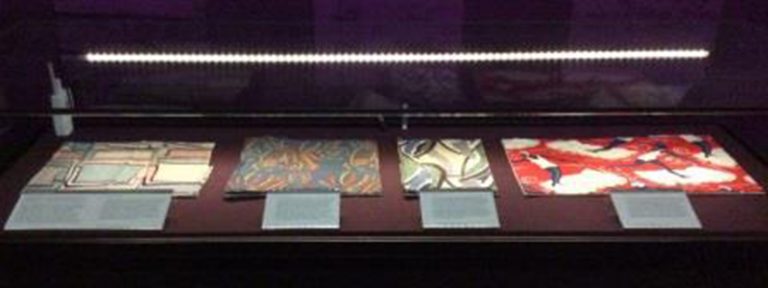Faded book spines, curtain backs, and tapestries; we’ve all witnessed the irreversible damage that light can cause to decorative objects. Such colour change can detrimentally affect the aesthetic appeal, interpretation, and accessibility of a collection. Like other heritage institutions, The National Archives strives to both preserve and provide access to its collections. A balance must be struck between exhibiting, and exposing the collection to potentially damaging light – or not exhibiting and restricting access to the collection. The National Archives’ exhibition lighting policy achieves this balance in most cases, but in others, such as the exhibition of unique and delicate textiles from the Board of Trade Design Registers that are prized for their colourful vibrancy, further analysis was required. In this case we used a technique called microfading to determine if the textiles could safely go on display in The Keeper’s Gallery.
Colourful textiles

Figure 1. Details of a textile (BT52/5373/372726) by the Calico Printers’ Association, registered in 1937 (left), and a dress fabric (BT52/4285/292274) designed by Alec Walker, registered in 1930 (right).
Four brightly coloured printed textiles (BT52/4285/292274, BT52/4079/272017, BT52/5373/372726, and BT52/3037/109909) dating from 1914 to 1937 were proposed for exhibition in The Keeper’s Gallery (Figures 1 and 2). These textiles are just a few of the many fascinating representations of copyrighted designs from The Board of Trade Design Registers. Crucially, the exhibits hadn’t been exposed to much light over their lifetime and as such the colours closely resembled the manufacturers’ original intentions. Preserving these colours was paramount and required selecting appropriate lighting conditions for the exhibition.

Figure 2. Details of a dress fabric (BT52/4079/272017) by Chanel, registered in 1929 (right) and a furnishing fabric (BT52/3037/109909) designed by Vanessa Bell, registered in1914 (left).
Exhibition lighting policy
The National Archives’ exhibition lighting policy details measures to minimise the impact of lighting on an object during exhibition based on the object’s light-sensitivity. An object is given one of four ratings ranging from’ vulnerable’, for objects most at risk of damage through light exposure, to low sensitivity, where there is little risk. Correct categorisation of an object is essential for achieving the optimum balance between access and preservation. Unfortunately for these particular textiles, categorisation was complicated by a lack of information on the light-sensitivity of the colours themselves. Without this evidence the textiles would be displayed based on the sensitivity of the base material they were printed on; in this case, woven textiles of wool, silk, cotton, and linen. This is fine if the colours are equally or less sensitive than the base material. However if the colours are more sensitive than the base material, the textiles could fade due to the light exposure. In order to determine which category the textiles belonged to we needed to find out the light-sensitivity of the colours in the textiles. An impossible task by eye but easily done using microfading.
Microfading

Figure 3. Microfading a green area of BT52/5375/372726 to assess its light-sensitivity.
Microfading involves measuring the colour change of an area that is exposed to a high-power beam of light over a specified period of time (normally 10 minutes or less). We conducted the test at UCL’s Centre for Sustainable Heritage (London) where we filtered the light to remove ultraviolet and infrared to replicate the conditions in The Keeper’s Gallery (Figure 3). Importantly for heritage institutions, such as The National Archives, microfading is a micro-destructive technique. While some fading occurs to the sample during testing it is barely if not invisible to the naked eye, due to the small size of the light beam used (3 µm diameter). Consequently, you can’t see the exposed area on the material once analysis is complete! The measured change in sample colour is only meaningful when compared to the ISO/Blue Wool Standards using the same experimental conditions. These standards are widely used in the heritage sector and form the basis of the light-sensitivity categories in the exhibition lighting policy.
Through microfading the textiles we identified that two of the four textiles were categorised ‘vulnerable’ due to the light-sensitivity of the colours in the designs.
Exhibition lighting conditions
In view of the results we decided that the textiles could be exhibited using the recommendations for ‘vulnerable’ materials i.e. that they can be exposed to light for up to 20,000 hours within a 5 year period. This equates to the planned 11 weeks of display in The Keeper’s Gallery that ends on the 18th May 2014 (Figure 4). During this time the colours of the textiles will be monitored using colorimetry to ensure that no perceptible colour change occurs during the exhibition.
 Microfading was vital in helping us to establish the correct lighting conditions for these rare and beautiful textiles, without compromising their preservation or unnecessarily limiting access.
Microfading was vital in helping us to establish the correct lighting conditions for these rare and beautiful textiles, without compromising their preservation or unnecessarily limiting access.
Dear Helen,
Thanks for this, I’d be very interested in knowing what your five light-sensitivity ratings are with the exposure limits for each, and also whether this has been developed specifically for the Board of Trade textile collection or extends further to other archive materials.
Thanks, Jane
I would like to find out more about the five ratings too. Is your ‘Exhibitions Lighting Policy’ available for public access?
Thanks, Lisa
Thanks Jane and Lisa for your comments. My apologies, there are four rather than five light-sensitivity ratings in our ‘Exhibition Lighting Policy’ – this is being changed in the blog post text. The policy was developed for the exhibition, both at The National Archives and when on loan, of all materials within the collection. It is not currently available online but we are happy to share it with other professionals and interested parties on request.
Thanks,
Helen
To request a copy of the Exhibition Lighting Policy please email consenquiries@nationalarchives.gsi.gov.uk and mention this blog post and my name in your request.
Thanks,
Helen
Thanks you for sharing the policy with us at the Oxford Conservation Consortium. I am currently updating our own lighting guidlines and am interested in the categorisation of some materials in your lighting policy document, notably that miniatures and watercolours are rated as being of “Medium Sensitivity”. You refer to the CIE paper “Control of Damage to Museum Objects by Optical Radiation” CIE 157:2004 ISBN 978 3 901906 27 5 by way of reference. It seems that this paper is no longer available. Does anyone have a copy that they could share or could you please elaborate as to why these two types of object are not classed as more sensitive?
With many thanks,
Celia Withycombe
Senior Conservator
Hi Celia,
Thanks for getting in touch with questions about the lighting policy. We were able to borrow the CIE publication through interlibrary loan from the British Library. The classification table is on page 18 and lists both watercolours and miniatures among other things as medium sensitivity (4,5,6 on the blue wool scale). If you can’t get a copy of the CIE publication I also saw an early draft of BS PD CEN/TS 16163:2014 Conservation of Cultural Heritage – Guidelines and procedures for choosing appropriate lighting for indoor exhibitions that had used the classification table from the CIE publication – not sure if it is still in the final publication as I’ve not got a copy, but if you have a copy of the new standard, you could see if they have used the CIE table.
Best wishes,
Sarah VanSnick
Preservation Manager